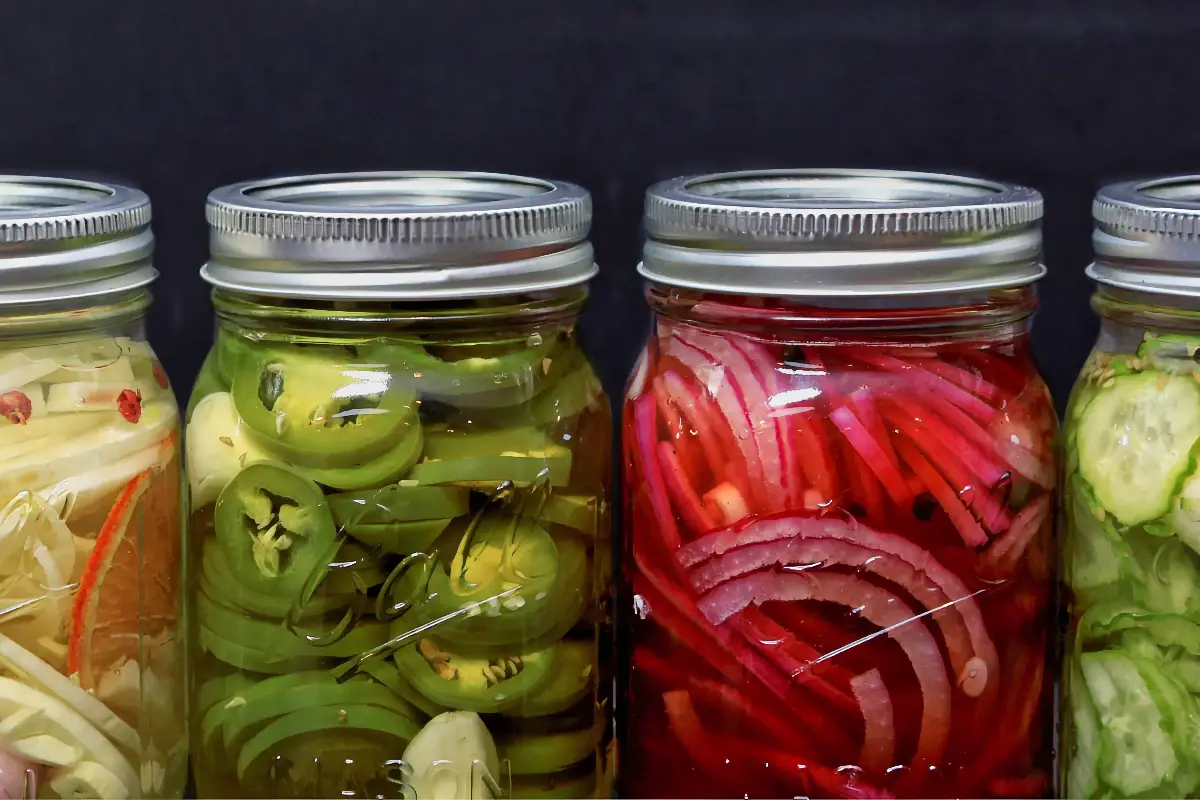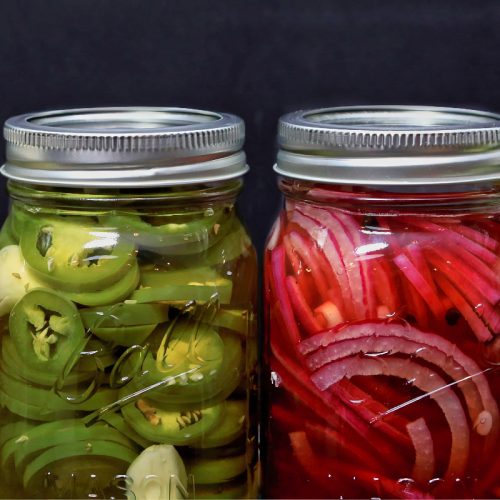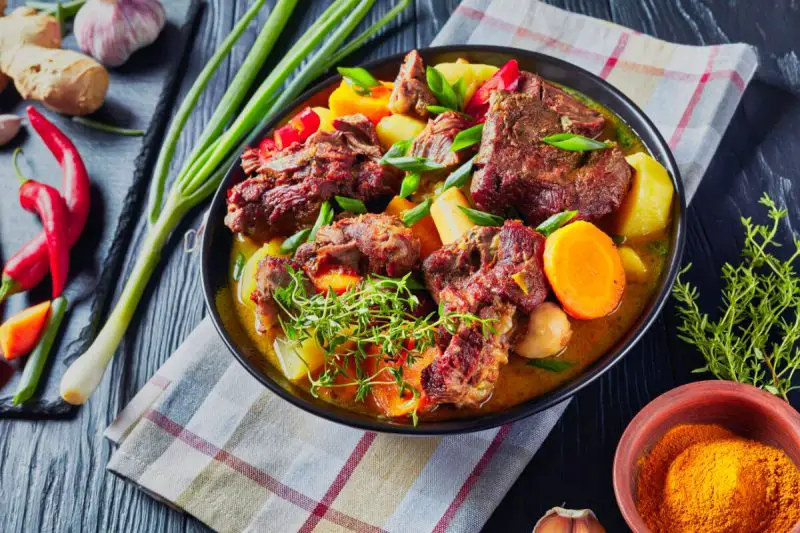
Delicious and fiery, Haitian Pikliz recipe has been a staple in Haitian cuisine for generations. This bright and sour condiment first appeared in Haiti but has since spread throughout the Caribbean.
It may be served as a side dish or as a main course because of the unusual combination of pickled vegetables, fragrant herbs, and hot Scotch bonnet peppers.
Want more ideas to round-out your Haitian Recipe Box?
A lot of great options are in these posts!
Pikliz’s origins may be traced back to Haiti’s rich cultural heritage. This tiny Caribbean country has a storied past thanks to its combination of indigenous Tano culture, African slaves, and French colonial rule.
You May Want to Join The World Recipes With Our Big Escape
Share your own recipes in our Facebook Group. Find recipes from all over the world. Learn more about International Cuisine and how you can surprise your family with new and exciting foods from all over the world.
For More Photos Visit Our Instagram at World Recipes Daily
The evolution of Haitian cuisine is the result of a synthesis of these various cultural influences, and Pikliz is no exception. The French are responsible for popularizing the practice of pickling, whereas the West African and Tano cultures are responsible for popularizing the use of robust, spicy spices.
The term “Pikliz” is a Creole version of the French word “piklès,” which is a French variant of the English word “pickles,” demonstrating the French influence on modern Haitian Creole.
Pikliz’s history, however, is a fascinating tale of perseverance, adaptability, and culinary creativity, and it has become something that is really Haitian.
Typically, cabbage, carrots, and bell peppers are among the vegetables used in the preparation of pikliz, along with a blend of vinegar, lime juice, and spices. The marinating and fermentation process gives the components a lively, spicy, and somewhat sour taste.
The recipe gets its signature heat from Scotch bonnet peppers, although the amount of spiciness can be modified to suit different tastes.
Haitian Pikliz recipe is commonly used as a condiment or side dish in Haitian cuisine. To complement fried or grilled meats, like the classic Haitian dish “griot,” its flavor and texture are perfect (fried pork).
Pikliz’s sour and spicy flavor is perfect for clearing the palette after a heavy meal and stimulating digestion. Sandwiches, rice, and stews all benefit from the addition of this flavorful ingredient.
The Haitian Pikliz recipe is the star of the show at parties and celebrations since it is such an integral part of Haitian culture. Whether it’s a regular family dinner, a special holiday meal, or a cultural celebration, this tangy condiment is always there to enhance the food’s flavor and represent Haiti’s diverse cultural heritage.
The Haitian Pikliz recipe is not only a tasty and adaptable condiment, but also a striking illustration of the island’s complicated history and many cultural influences.
It represents the perseverance and innovation of the Haitian people, who have drawn from many different culinary traditions to develop their own distinctive cuisine.
So the next time you enjoy the spicy aromas of Pikliz, keep in mind that you are enjoying a tiny but meaningful part of Haitian heritage and history.
3 Reasons People Love the Haitian Pikliz Recipe
1. Bold and Vibrant Flavor Profile: Haitian Pikliz’s popularity can be attributed in large part to the dish’s robust and enticing flavor. Tangy, spicy, and somewhat sour describe the flavor profile achieved by combining pickled vegetables, fragrant herbs, and scorching Scotch bonnet peppers. Pikliz is a popular condiment since its tastes enhance and compliment those of many other foods.
Vinegar and lime juice are used in the pickling process to keep the veggies crunchy and to offer a tangy acidity that balances the heavy flavors of many traditional Haitian recipes. The fierce heat of the Scotch bonnet peppers, a signature ingredient in Caribbean cooking, may be tweaked to suit different tastes. The end product is a wonderful flavor explosion that stimulates the taste buds and stays with the mind.
2. Cultural Significance and History: The rich cultural importance and history of Haitian Pikliz also contribute to its widespread popularity. Pikliz is a Haitian dish that has changed over time, reflecting the country’s multifaceted cultural history and drawing inspiration from the cuisines of the native Tano people, African slaves, and French conquerors. Pikliz, with its distinctive blend of flavors and ingredients, is both a tasty condiment and a symbol of Haiti’s tenacity and ability to adapt to new circumstances.
Because of its long history and central place in Haitian culture, Pikliz is more than just a delicious dish. The Haitian people take great pleasure in their culinary heritage, and one way they show this passion is by serving Pikliz during celebrations, festivals, and other cultural events.
3. Health Benefits and Versatility: Finally, Haitian Pikliz is popular due to its many uses and high popularity. The pickling procedure that went into making Pikliz is an all-natural way to preserve food that doesn’t include any chemicals. In addition, the fermentation method used to create Pikliz promotes the growth of probiotics, which are crucial to a healthy digestive system.
Pikliz is made using vegetables that are rich in vitamins, minerals, and antioxidants, such as cabbage, carrots, and bell peppers. The immune system, digestion, and general health are all bolstered by these minerals.
Pikliz’s adaptability means it has several uses in the kitchen. It adds a burst of flavor to sandwiches, rice dishes, and stews, and goes well with grilled or fried meats like the classic Haitian meal “griot” (fried pig). Its sour and spicy flavor is great for digestion and cleansing the palette after heavy meals.

How To Make Our Haitian Haitian Pikliz Recipe
Ingredients: (8 servings)
1/2 small head of cabbage, finely shredded
1 large carrot, julienned or grated
1/2 medium bell pepper (any color), thinly sliced
1 small onion, thinly sliced
2 scallions, chopped
2-3 Scotch bonnet peppers, seeds removed and finely chopped (adjust to desired spice level)
1 teaspoon kosher salt
1/2 teaspoon black peppercorns
2 cloves garlic, minced
1/2 teaspoon dried thyme
1 cup white vinegar
1/4 cup freshly squeezed lime juice
Instructions
In a large mixing bowl, combine the shredded cabbage, carrot, bell pepper, onion, and scallions. Mix well.
Add the chopped Scotch bonnet peppers, salt, black peppercorns, minced garlic, and dried thyme to the vegetable mixture, stirring well to combine.
In a separate bowl or measuring cup, combine the white vinegar and lime juice.
Pour the vinegar and lime juice mixture over the vegetables, ensuring that all the ingredients are submerged. If needed, add more vinegar to cover the vegetables completely.
Transfer the mixture to a clean, airtight glass jar or container. Seal the container and refrigerate for at least 24 hours to allow the flavors to meld and the vegetables to pickle. For best results, allow the Pikliz to marinate for 2-3 days before serving.
Serve your Haitian Pikliz as a side dish or condiment with your favorite meals. The Pikliz can be stored in the refrigerator for up to 3 weeks.
Nutritional Information For the Haitian Pikliz Recipe
Calories: 38
Carbohydrates: 5g
Protein: 1g
Fat: 0g
Saturated Fat: 0g
Cholesterol: 0mg
Sodium: 305mg
Potassium: 160mg
Fiber: 1g
Sugar: 3g
Please note that these values are approximate and may vary depending on the specific ingredients used.
Prep Time: 20 minutes
Cooking Time: There is no actual cooking time for the Haitian Pikliz recipe, as it is a pickled dish. However, the marinating time, which allows the flavors to meld and the vegetables to pickle, is a crucial part of the process:
Marinating Time: At least 24 hours (for best results, allow the Pikliz to marinate for 2-3 days before serving)
Pots, Pans, and Cooking Equipment Needed for the Haitian Pikliz Recipe
Large mixing bowl
Measuring cups and spoons
Cutting board
Sharp knife
Vegetable peeler or grater (for carrots)
A clean, airtight glass jar or container (approximately 1-quart capacity)
Best Way to Store Leftovers For the Haitian Pikliz
Store any leftover Haitian Pikliz in the same airtight glass jar or container used for the pickling process. Make sure the container is well-sealed and keep it in the refrigerator. The Pikliz can be stored for up to 3 weeks.
Possible Substitutions for Ingredients For the Haitian Pikliz
If Scotch bonnet peppers are not available, you can substitute them with habanero peppers, which have a similar heat level, or other hot chili peppers according to your preference and tolerance.
Apple cider vinegar can be used in place of white vinegar for a slightly different flavor profile.
Fresh thyme can be used instead of dried thyme. Use about 1 tablespoon of chopped fresh thyme to substitute for the 1/2 teaspoon of dried thyme.
Ingredients to Substitute for a Vegetarian Version of the Haitian Pikliz
The original Haitian Pikliz recipe is already vegetarian-friendly, as it contains only vegetables, herbs, and spices.
Tips and Tricks for Easier Creation
To reduce the heat level, remove the seeds and membranes from the Scotch bonnet peppers before chopping.
Wear gloves when handling the Scotch bonnet peppers to prevent skin irritation or accidentally touching your eyes with the pepper’s heat.
Use a mandoline slicer to get evenly shredded cabbage, julienned carrots, and thinly sliced bell pepper and onion.
Possible Side Dishes and Desserts to Serve With the Haitian Pikliz
Griot (Haitian fried pork)
Diri ak pwa (Haitian rice and beans)
Fried plantains
Accra (Haitian malanga fritters)
Pain Patate (Haitian sweet potato bread)
Haitian pineapple upside-down cake
How To Serve the Haitian Pikliz
Serve the Haitian Pikliz as a side dish or condiment alongside various meals. It pairs well with grilled or fried meats, rice dishes, stews, and sandwiches. Place a small serving spoon or fork in the jar or container, allowing guests to add the desired amount of Pikliz to their plates. Remember that a little goes a long way, as the flavors are bold and spicy.
FAQs About the Haitian Pikliz
How spicy is Haitian Pikliz?
The spiciness of Haitian Pikliz largely depends on the amount of Scotch bonnet peppers used in the recipe. These peppers are known for their intense heat, but you can adjust the quantity to suit your personal preference. To reduce the heat, remove the seeds and membranes from the peppers before chopping. Alternatively, use a milder chili pepper if you prefer less heat.
Can I make Haitian Pikliz without cabbage?
Yes, you can make Haitian Pikliz without cabbage. Although cabbage is a traditional ingredient, you can substitute it with other crunchy vegetables like jicama, kohlrabi, or even thinly sliced cauliflower. Keep in mind that this will slightly alter the taste and texture of the final product.
Can I use a different type of vinegar for the pickling process?
White vinegar is commonly used in Haitian Pikliz recipes, but you can experiment with other types of vinegar, such as apple cider vinegar or red wine vinegar. Keep in mind that this may change the flavor profile of the Pikliz, so choose a vinegar that complements the other ingredients in the recipe.
How long does Haitian Pikliz last in the refrigerator?
Haitian Pikliz can be stored in an airtight container in the refrigerator for up to 3 weeks. The pickling process helps preserve the vegetables and extend their shelf life. As the Pikliz ages, the flavors will continue to meld, and the heat from the peppers may intensify.
Can I use Haitian Pikliz as a marinade for meats or vegetables?
While Haitian Pikliz is traditionally served as a side dish or condiment, you can also use it as a marinade for meats or vegetables. The vinegar and lime juice in the recipe help to tenderize proteins, and the spicy, tangy flavors can add a unique twist to your dish. Simply marinate your chosen ingredients in the Pikliz for a few hours or overnight, then cook as desired.
Final Thoughts
As a culinary expression of Haiti’s colorful essence and rich cultural past, Haitian Pikliz is a fascinating and treasured invention. This relish is a celebration of powerful tastes and textures, with pickled veggies, hot Scotch bonnet peppers, and aromatic herbs all coming together in perfect harmony to make one irresistible condiment. Pikliz is a celebration of the ingenuity and resourcefulness of the Haitian people, and it also happens to be a fantastic seasoning for many different cuisines.
A tale of cross-cultural exchange and culinary creativity, the origins of Haitian Pikliz are fascinating. This fiery sauce, which has been traced back to the indigenous Tano people, African slaves, and French conquerors, exemplifies the cultural melting pot that is the Caribbean. The Haitian people still hold Pikliz as a sign of their rich cultural history and a point of national pride.
Pikliz’s adaptability in the kitchen is one of the reasons it has gained such a following. This spicy spice goes great with a wide range of foods, including rice, stews, sandwiches, and grilled or fried meats (like the traditional Haitian griot). Pikliz is a great addition to rich, meaty meals because of its acidic, spicy character, which also acts as a palate cleanser and assists with digestion.
The Haitian Pikliz has a variety of health advantages in addition to its delicious taste and culinary adaptability. The veggies in this dish are packed with vitamins, minerals, and antioxidants, and the pickling process promotes the growth of helpful bacteria that aid with digestive health. Pikliz is a wonderful option for health-conscious eaters since it is made with all-natural ingredients and preserved using time-honored techniques.
Pikliz’s convenience and ease of use are further selling points. This well-loved Haitian sauce may be easily re-created by home cooks with a few inexpensive ingredients and some basic methods. One may adjust the flavor of their Pikliz to their liking by experimenting with different vinegars, peppers, and veggies.
Many people all around the world have fallen in love with Haitian Pikliz because it is unlike anything else in the culinary world. Haitians and foodies all around the world continue to adore it because of its robust tastes, storied past, and remarkable adaptability. Food has the capacity to bring people together, keep traditions alive, and create lasting memories; Pikliz is a symbol of Haiti’s culinary legacy and a celebration of the country’s many influences.
The magic of Haitian Pikliz, after all, is in the way it takes everyday food and makes it into something truly unforgettable. This flavorful sauce has been enjoying much-deserved success and widespread acclaim as more and more people learn to love it. Haitian Pikliz, a staple of Caribbean cuisine, is a proud example of Haiti’s gastronomic tradition that has endured through the years and is served at many social and cultural events.
Haitian Pikliz Is The Best Haiti Fermented Dish
Equipment
- Large mixing bowl
- Measuring cups and spoons
- Cutting board
- Sharp knife
- Vegetable peeler or grater (for carrots)
- A clean, airtight glass jar or container (approximately 1-quart capacity)
Ingredients
- 1/2 small head of cabbage, finely shredded
- 1 large carrot, julienned or grated
- 1/2 medium bell pepper (any color), thinly sliced
- 1 small onion, thinly sliced
- 2 scallions, chopped
- 2 Scotch bonnet peppers, seeds removed and finely chopped (adjust to desired spice level)
- 1 tsp kosher salt
- 1/2 tsp teaspoon black peppercorns
- 2 cloves garlic, minced
- 1/2 tsp dried thyme
- 1 cup white vinegar
- 1/4 cup freshly squeezed lime juice
Instructions
- In a large mixing bowl, combine the shredded cabbage, carrot, bell pepper, onion, and scallions. Mix well.
- Add the chopped Scotch bonnet peppers, salt, black peppercorns, minced garlic, and dried thyme to the vegetable mixture, stirring well to combine.
- In a separate bowl or measuring cup, combine the white vinegar and lime juice.
- Pour the vinegar and lime juice mixture over the vegetables, ensuring that all the ingredients are submerged. If needed, add more vinegar to cover the vegetables completely.
- Transfer the mixture to a clean, airtight glass jar or container. Seal the container and refrigerate for at least 24 hours to allow the flavors to meld and the vegetables to pickle. For best results, allow the Pikliz to marinate for 2-3 days before serving.
- Serve your Haitian Pikliz as a side dish or condiment with your favorite meals. The Pikliz can be stored in the refrigerator for up to 3 weeks.


